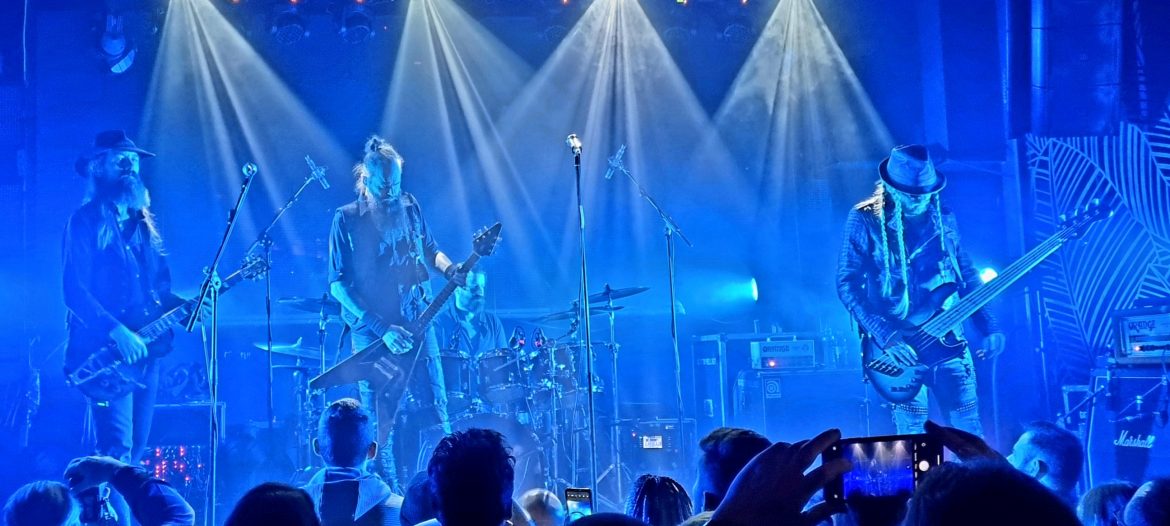SOM, the Massachusetts-based supergroup warmed up the evening last night before Sólstafir and Katatonia came out at the sold-out show at Madrid’s Changó club.
SOM, el supergrupo de Massachusetts, calentó la noche, antes de que Sólstafir y Katatonia salieran al escenario en el club Changó de Madrid, con el cartel colgado de entradas agotadas.
First, there was darkness, accompanied by low chanting in a foreign tongue, quickly followed by images on the huge screen above the stage of a B-movie Icelandic hero thwarting a human sacrifice.
Todo empezó con oscuridad, acompañada de cánticos bajos en una lengua extranjera, seguida rápidamente por escenas de una película de serie B islandesa con un sacrificio humano y una especie de héroe salvador en la enorme pantalla sobre el escenario.
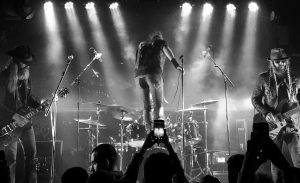
With these images etched on our minds, out came the 4 members of the Icelandic band, led by their lanky singer and guitarist Aðalbjörn Tryggvason, clinging to his gorgeous Flying V with a dragon carved on it. In fact, the irreproachable sound and powerful, elaborate staging of the quartet would set the tone for what was yet to come.
Con estas imágenes en nuestra retina, salieron los 4 miembros del grupo islandés, encabezados por la poderosa imagen de su cantante y guitarrista Aðalbjörn Tryggvason con su hermosa Flying V tallada con el dibujo de un dragón. De hecho, el sonido irreprochable y la poderosa y elaborada puesta en escena del cuarteto marcarían la pauta de lo que estaba por venir.
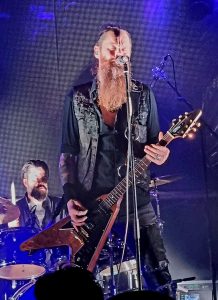
Both of us agree that there’s something about Sólstafir’s music that we can’t put our fingers on. It gets to your bones. In my case (Jessica), I’d like to think that it has something to do with the fact that my ancestors came from Denmark, and most likely Iceland. Rafa says it could be because he’s visited Iceland so many times, it feels sort of like home. But, all that is probably just wishful thinking. We know that it must have more to do with the visceral, haunting harmonies or the thundering bass lines and cadenced rhythms that conjure up visions of dark, Norse gods. Or, maybe it’s the introspective, yet tragic voice of their frontman: there’s no need to understand what Addi is singing. He personifies the Icelandic lyrics, at times wandering around the stage waving his arms around as if he were flying, and at others, throwing himself down on the floor. In fact, at one point, he got so into his guitar solo that he inadvertently hit a fan in the front row on the forehead with his guitar, only to subsequently place his palm on the bleeding fan’s head as if he were “Father” Tryggvason in some sort of baptismal ritual.
Los dos estamos de acuerdo en que no sabemos explicar lo que este grupo consigue transmitirnos. Te llega a la médula. En mi caso, (Jessica), me gustaría pensar que tiene algo que ver con el hecho de que mis antepasados vinieron de Dinamarca y muy probablemente de Islandia. Rafa dice que podría deberse a que, después de haber visitado Islandia varias veces, se siente como en casa. Pero, sabemos que, en realidad, debe tener más que ver con las armonías viscerales e inquietantes o las líneas de bajo atronadoras y ritmos cadenciosos que evocan visiones de oscuros dioses nórdicos. O tal vez tenga que ver con la voz introspectiva pero trágica de su frontman: no hay necesidad de entender lo que Addi está cantando. Es la personificación de esas letras islandesas. A veces, se mueve libremente por el escenario, moviendo los brazos como si volara. Otras veces, se tira al suelo. De hecho, hubo un momento en que se metía tanto en su solo de guitarra que golpeó en la frente con su guitarra a un fan en la primera fila, solo para luego colocar su palma sobre la cabeza sangrante del herido como si fuera el “sacerdote” Tryggvason en una especie de ritual bautismal.
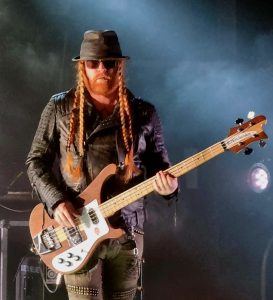
But the key to Sólstafir‘s unique sound is thanks to ‘Svabbi’ Austmann, on bass, with his long ginger-hued braids, ‘Grimsi’ Hallgrímsson on drums – serious, unremitting and sober throughout the concert, and the glaring, impressive presence of ‘Pjúddi’ Sæþórsson on guitar. More reminiscent of the typical ‘bad guy’ from a western with his wide-brimmed hat and austere stance, Sæþórsson played chord after beautiful chord of precise, hypnotic notes. No frills or artifice there… No smile, either.
Pero ese sonido tan único de Sólstafir también proviene de ‘Svabbi’ Austmann al bajo con sus 4 largas trenzas pelirrojas, ‘Grimsi’ Hallgrímsson a la batería – serio, incansable y sobrio durante todo el concierto, y la impresionante presencia de ‘Pjúddi’ Sæþórsson a la guitarra: una imagen más de malo de película del oeste y una forma de tocar la guitarra sencilla, llena de acordes y notas precisas sin florituras ni artificios, y sin una sonrisa tampoco.
The four-piece’s powerful rhythmic base that slowly and steadily climbed from almost peaceful, atmospheric euphony and evocative melodies, to moments of rage and metallic power, drove the engrossed crowd into a kind of psychedelic trance.
Una base rítmica potente del cuarteto, que ascendió lenta y constantemente desde una eufonía atmosférica casi pacífica con sus melodías evocadoras, hasta momentos de ira y poder metálico, llevó a una multitud completamente absorta a una especie de trance psicodélico.
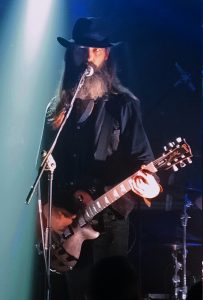
After a little over an hour of this marvelous, hypnotic trip, Sólstafir forewarned the packed club that their set was coming to an end by once again projecting images on the previously-darkened screen – this time a volcano eruption – as they closed with classics like the addictive ‘Ottà‘ (“dawn”) and ‘Goddess of the Ages‘, exceeding our expectations and leaving us pining for more. We would have preferred a longer set, but alas, it was time to clear the stage for Katatonia, which apparently was the big event of the night for much of the crowd, which seemed a little cold at times. In fact, no signature Tryggvason selfies for Madrid’s crowd…
Después de poco más de una hora de este maravilloso e hipnótico viaje, Sólstafir advirtió al público que su set estaba llegando a su fin, al proyectar una vez más imágenes en la pantalla previamente oscurecida – esta vez una erupción volcánica – mientras cerraban su set con clásicos como la adictiva ‘Ottà’ (que significa “amanecer”) y ‘Goddess of the Ages’, superando nuestras expectativas y dejándonos con ganas de más. Habríamos preferido un set más largo, pero, por desgracia, era hora de dejar el escenario libre para Katatonia, que aparentemente fue el gran acontecimiento de la noche, ya que se notaba la gente un poco fría con el cuarteto islandés. De hecho, esta vez no habría ningún selfie característico de Tryggvason…
Text / Photos: Jessica Jacobsen & Rafael Pajares

